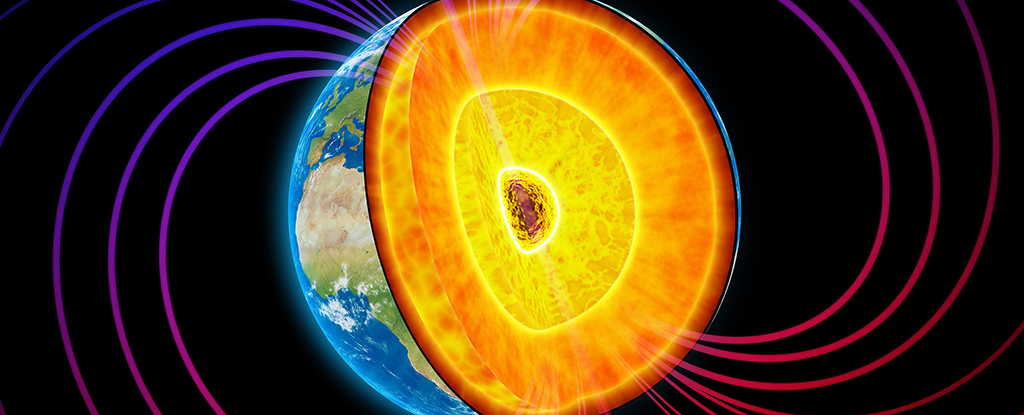Mysterious ‘doughnut’ structure found in Earth’s core
- September 2, 2024
- 0
About 1,800 miles (2,890 kilometers) beneath our feet lies a giant ball of liquid metal: our planet’s core. Scientists like me use seismic waves created by earthquakes as
About 1,800 miles (2,890 kilometers) beneath our feet lies a giant ball of liquid metal: our planet’s core. Scientists like me use seismic waves created by earthquakes as

About 1,800 miles (2,890 kilometers) beneath our feet lies a giant ball of liquid metal: our planet’s core. Scientists like me use seismic waves created by earthquakes as a kind of ultrasound to “see” the core’s shape and structure.
My colleague Xiaolong Ma and I, using a new way of studying these waves, made a surprising discovery: There is a large, doughnut-shaped core region around the equator, several hundred kilometers thick, where seismic waves travel about 2% slower than in other regions of the core.
“We believe that this region contains lighter elements such as silicon and oxygen and may play an important role in the huge liquid metal flows flowing through the core that create the Earth’s magnetic field. Our results are published in Science Advances.”
Most studies of seismic waves generated by earthquakes look at the large initial wave fronts that propagate around the world about an hour after the earthquake.
We realized that we could learn something new by looking at the later, weaker part of these waves, known as the coda, the part that ends a piece of music. Specifically, we tested how similar the codes recorded by different seismic detectors were several hours after they started.
Mathematically, this similarity is measured by something called correlation. We collectively call these similarities in the tail-end of earthquake waves the “codacorrelation wavefield.”
“By looking at the coda-correlation wavefield, we discovered tiny signals from multiple reverberating waves that we wouldn’t otherwise see. By understanding the paths of these reverberating waves and matching them to signals in the coda-correlation wavefield, we were able to determine how long it took for them to travel across the planet.”
We then compared what we saw from seismic detectors closer to the poles with the results closer to the equator. In general, waves detected closer to the poles were moving faster than waves closer to the equator.
We tested many computer models and simulations of what conditions in the core could produce such results. We eventually discovered that there must be a torus, a doughnut-shaped region in the outer core around the equator where waves travel more slowly.
This region has previously been undetectable to seismologists. However, using the coda correlation wavefield allows us to “see” the outer core in greater detail and more smoothly. Previous studies have shown that waves travel slower everywhere around the “ceiling” of the outer core. However, in this study we have shown that the low-velocity region is only close to the equator.
The Earth’s outer core has a radius of about 3,480 km, making it slightly larger than the planet Mars. It is composed primarily of iron and nickel, with trace amounts of lighter elements such as silicon, oxygen, sulfur, hydrogen, and carbon.
The bottom of the outer core is hotter than the top, and the temperature difference causes the liquid metal to move like water in a boiling pot on a stove. This process is called thermal convection, and we believe that the constant movement must mean that all the material in the outer core is fairly well mixed and homogeneous.
But if the outer core is filled with the same material everywhere, seismic waves should travel everywhere at the same speed. So why do these waves slow down in the doughnut-shaped region we found?
We believe that there should be a greater concentration of light elements in this region. They can be released from the solid inner core of the Earth into the outer core where buoyancy forces create more convection.
Why do lighter elements accumulate more in the equatorial region of the torus? Scientists believe this can be explained by the transfer of more heat from the outer core to the rocky mantle above it in this region.
Another planetary-scale process is at work in the outer core. The rotation of the Earth and the small, solid inner core cause the outer core fluid to organize itself into long, vertical vortices that move from north to south like giant water wells.
The turbulent motion of liquid metal in these vortices creates a “geodynamics” responsible for creating and maintaining Earth’s magnetic field, which protects the planet from harmful solar winds and radiation, making life on the surface possible.
A more detailed picture of the structure of the outer core, including a new ring of lighter elements, will help us better understand Earth’s magnetic field. In particular, how the field changes its intensity and direction over time is critical to life on Earth and the potential habitability of planets and exoplanets.
Source: Port Altele
As an experienced journalist and author, Mary has been reporting on the latest news and trends for over 5 years. With a passion for uncovering the stories behind the headlines, Mary has earned a reputation as a trusted voice in the world of journalism. Her writing style is insightful, engaging and thought-provoking, as she takes a deep dive into the most pressing issues of our time.